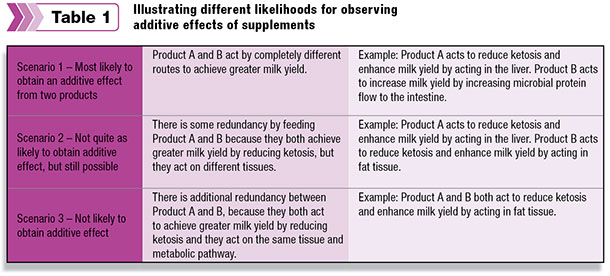Dairy producers and their nutrition advisers have an ever-expanding list of supplements that can be considered when formulating diets. These products include modifiers of rumen fermentation, silage additives, protected nutrients and modulators of nutrient metabolism.
If five people visit your farm and each one promises 3 pounds additional milk per cow per day if you use their product, will you get 15 pounds of additional milk per day if you use them all? Probably not. How does one go about deciding which product or products should strategically be incorporated into their diets?
Is there quality research?
Consider the data shown in Figure 1 for a product that claims to increase milk protein percentage. The initial reaction may be that the response looks impressive. But thoughtful examination brings about more questions than answers.

How meaningful are the treatment differences? The y axis does not start at zero, so the response is actually quite small (0.04 percentage units) despite the graph making it look like a twofold response.
There is no indication of the amount of replication that went into generating the data. Does each treatment represent the response of one cow or 20 cows? One farm or 20 farms? If there is replication, what is the extent of variation in the responses among the replicates?
How confident are you that you would obtain the same response from cows on your farm? What is your return on investment? Was this data generated by university research or by the company marketing the product?
It is very important to consider the source of information used by a supplier to establish the efficacy of their product. The “gold standard” is for manufacturers to have research that has been conducted on their product by a university and published in a peer-reviewed scientific journal.
The peer-review process includes an extensive evaluation of the research by professionals to make sure the experimental design and statistical analysis of the results were of sufficient quality to allow the reader to have confidence in the data and hence warrant publication of the results.
These reports have detailed information regarding the degree of replication, the variation in response among animals (or farms) and the likelihood that the effects of the product (or lack thereof) are real.
While peer-reviewed research may be the gold standard, it may have limitations. For example, the research may have been conducted top-dressing the supplement to cows in a tiestall barn, but your farm may have a freestall barn and the supplement will be mixed into a TMR.
Nutrition advisers can help you determine how important the differences between research conditions and conditions on your farm may be and if they might influence the response on your farm.
Beware of information on a supplement generated by a manufacturer “in house,” i.e., in their labs or on client farms. While there are examples of well-designed research conducted by suppliers of supplements, my experience is: These are the minority.
The same standard should apply to research conducted by a supplier as to research conducted by a university: Have the results been published in a peer-reviewed journal?
Is there an economic return?
Research can give us information regarding a likely response from using a product, but rarely does it provide an evaluation of whether the response is of sufficient magnitude to be economically advantageous to the producer. Obviously, this is an important consideration when deciding whether to incorporate a supplement into your diet.
Unfortunately, typically there is insufficient thought that goes into the economics of supplementation. For example, all too often, a supplement may get consideration if the cost is less than a certain amount (e.g., $0.05 per cow per day) but not receive consideration if it costs more than that.
This simplistic reasoning makes absolutely no sense. It totally ignores the recommended duration of feeding, or total investment, as well as the economic return from that investment.
Manufacturers of supplements will often provide a return on investment (ROI) when using their product. An ROI will list the economic return when using the product (e.g., added milk production, improved reproductive efficiency, lower incidence of disease, etc.) versus the cost of using the product. While this does give an estimate of the profitability when using the supplement, there are two important caveats.
First, where does the data come from for estimates of improved production, reproduction and health? This gets back to our discussion above: What is the quality of the research?
The second caveat is that an ROI assumes cows in your herd obtain the same magnitude of response as those used in the calculation. Clearly, not every herd gets an identical response to a supplement. An ROI does not provide any sort of risk assessment when using a product.
This caveat leads to a discussion of a “gold standard” for evaluating economic returns when using a supplement. David Galligan and co-workers at the University of Pennsylvania published a method for determining the likelihood of obtaining an economic return above breakeven (or below breakeven) when considering the cost of feeding a supplement and observed milk production responses and changes in feed intake obtained from multiple trials (Journal of Dairy Science, Vol. 74, pgs. 902 to 910).
Their methodology also estimates the cost per cow per day when using the product if a herd’s response is below the breakeven point. Conversely, it also estimates the cost of not using the product when a herd’s production response is above breakeven.
Use of this methodology requires that results from multiple trials are available so estimates of herd-to-herd variation in responses can be made. While this type of analysis is not commonly available, there are a handful of supplements in which there are multiple trials to facilitate this type of analysis (e.g., yeast, sodium bicarbonate, Rumensin, rumen-protected choline).
Are there additive effects when using multiple supplements?
Earlier we asked: If five people visit your farm and each one promises 3 pounds per day additional milk if you use their product, will you get 15 pounds of additional milk per day? Unfortunately, rarely are two or more products tested together in the same research trial.
Consequently, we need to employ some common sense to guesstimate the likelihood of an additive response. Consider three scenarios represented in Table 1. In each scenario, the desired outcome is greater milk yield.

The key to whether there may be an additive effect depends, mechanistically, on how closely the two products act in the animal to achieve the outcome and whether the cow has the genetic potential to respond.
A couple caveats
Not all products with the same generic name are the same. For example, not all yeast products are the same. Similarly, not all rumen-protected nutrient products (e.g., protected choline, methionine, lysine) or organic trace mineral products are the same.
Different technologies are often employed by different manufacturers to produce what on the surface may seem to be the same product. Unfortunately, there have been occasions when a manufacturer of one product “borrows” research conducted on another manufacturer’s product.
If the technology to produce the products differs, the efficacy may also differ. Ask for research specific to the product being considered.
My last caveat is a tough one for dairy producers to deal with. Manufacturers may not share all of the research that has been published in peer-reviewed journals. For example, if one trial is positive, but four are neutral or negative, are results from all five trials shared?
Final comments
Most dairy producers want to know if a product works on their farm and tend to be skeptical of research conducted at other locations. However, it is very difficult to evaluate responses to a supplement on a commercial farm because of other changes that may occur at the same time the supplement is fed.
Simultaneous changes in forage source, environmental temperature, stocking density, etc., make it challenging to interpret responses on the farm and justify the dependence on well-designed and controlled research to assist in making decisions.
Clearly, choosing supplements that will be profitable on your farm becomes a very complex process. Dairy producers do not have the time to sift through all the complexities and caveats discussed in this article for every supplement.
They must depend on their nutrition advisers to help them. Hiring competent advisers who you can trust becomes imperative. The good news is: The educational training of nutrition consultants has increased dramatically in the past few decades, and there are many excellent ones who can help you.
Hold their feet to the fire on some of the issues discussed above. Make sure they keep the bar high when evaluating supplements. PD

-
Ric R. Grummer
- Professor Emeritus
- Department of Dairy Science
- University of Wisconsin – Madison
- Email Ric R. Grummer










